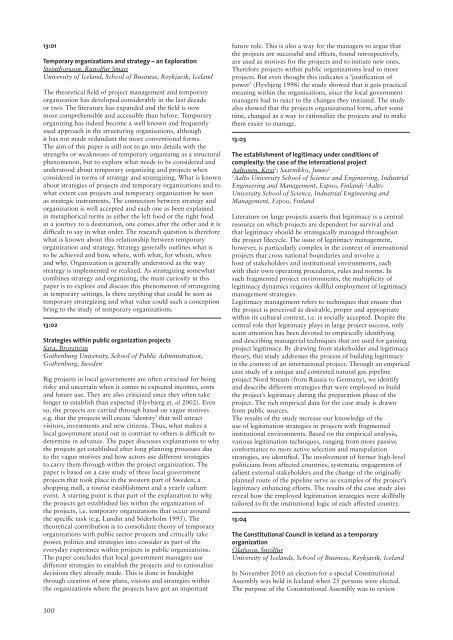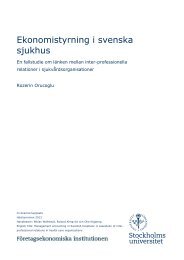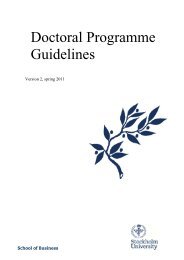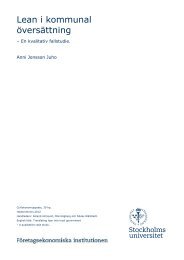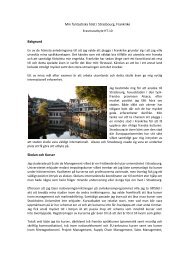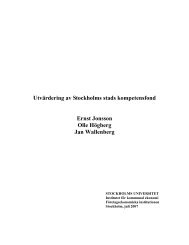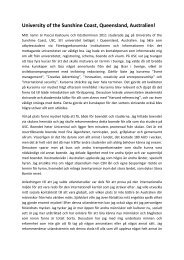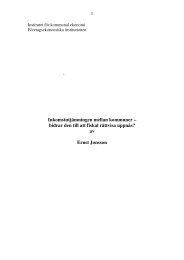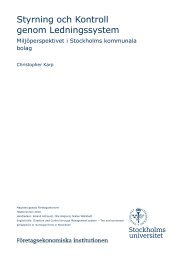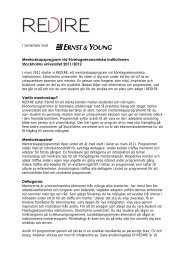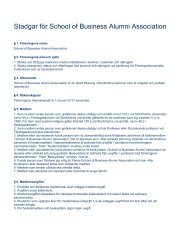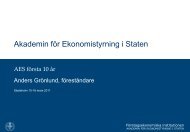Download full programme and abstract book pdf 1.6
Download full programme and abstract book pdf 1.6
Download full programme and abstract book pdf 1.6
You also want an ePaper? Increase the reach of your titles
YUMPU automatically turns print PDFs into web optimized ePapers that Google loves.
13:01<br />
Temporary organizations <strong>and</strong> strategy – an Exploration<br />
Steinthorsson, Runolfur Smari<br />
University of Icel<strong>and</strong>, School of Business, Reykjavik, Icel<strong>and</strong><br />
The theoretical field of project management <strong>and</strong> temporary<br />
organization has developed considerably in the last decade<br />
or two. The literature has exp<strong>and</strong>ed <strong>and</strong> the field is now<br />
more comprehensible <strong>and</strong> accessible than before. Temporary<br />
organizing has indeed become a well known <strong>and</strong> frequently<br />
used approach in the structuring organisations, although<br />
it has not made redundant the more conventional forms.<br />
The aim of this paper is still not to go into details with the<br />
strengths or weaknesses of temporary organizing as a structural<br />
phenomenon, but to explore what needs to be considered <strong>and</strong><br />
understood about temporary organizing <strong>and</strong> projects when<br />
considered in terms of strategy <strong>and</strong> strategizing. What is known<br />
about strategies of projects <strong>and</strong> temporary organizations <strong>and</strong> to<br />
what extent can projects <strong>and</strong> temporary organization be seen<br />
as strategic instruments. The connection between strategy <strong>and</strong><br />
organization is well accepted <strong>and</strong> each one as been explained<br />
in metaphorical terms as either the left food or the right food<br />
in a journey to a destination, one comes after the other <strong>and</strong> it is<br />
difficult to say in what order. The research question is therefore<br />
what is known about this relationship between temporary<br />
organization <strong>and</strong> strategy. Strategy generally outlines what is<br />
to be achieved <strong>and</strong> how, where, with what, for whom, when<br />
<strong>and</strong> why. Organization is generally understood as the way<br />
strategy is implemented or realized. As strategizing somewhat<br />
combines strategy <strong>and</strong> organizing, the main curiosity in this<br />
paper is to explore <strong>and</strong> discuss this phenomenon of strategizing<br />
in temporary settings. Is there anything that could be seen as<br />
temporary strategizing <strong>and</strong> what value could such a conception<br />
bring to the study of temporary organizations.<br />
13:02<br />
Strategies within public organization projects<br />
Sara, Brorström<br />
Gothenburg University, School of Public Administration,<br />
Gothenburg, Sweden<br />
Big projects in local governments are often criticised for being<br />
risky <strong>and</strong> uncertain when it comes to expected incomes, costs<br />
<strong>and</strong> future use. They are also criticized since they often take<br />
longer to establish than expected (Flyvbjerg et. al 2002). Even<br />
so, the projects are carried through based on vague motives<br />
e.g. that the projects will create ’identity’ that will attract<br />
visitors, investments <strong>and</strong> new citizens. Thus, what makes a<br />
local government st<strong>and</strong> out in contrast to others is difficult to<br />
determine in advance. The paper discusses explanations to why<br />
the projects get established after long planning processes due<br />
to the vague motives <strong>and</strong> how actors use different strategies<br />
to carry them through within the project organization. The<br />
paper is based on a case study of three local government<br />
projects that took place in the western part of Sweden; a<br />
shopping mall, a tourist establishment <strong>and</strong> a yearly culture<br />
event. A starting point is that part of the explanation to why<br />
the projects get established lies within the organization of<br />
the projects, i.e. temporary organizations that occur around<br />
the specific task (e.g. Lundin <strong>and</strong> Söderholm 1995). The<br />
theoretical contribution is to consolidate theory of temporary<br />
organizations with public sector projects <strong>and</strong> critically take<br />
power, politics <strong>and</strong> strategies into consider as part of the<br />
everyday experience within projects in public organizations.<br />
The paper concludes that local government managers use<br />
different strategies to establish the projects <strong>and</strong> to rationalize<br />
decisions they already made. This is done in hindsight<br />
through creation of new plans, visions <strong>and</strong> strategies within<br />
the organizations where the projects have got an important<br />
100<br />
future role. This is also a way for the managers to argue that<br />
the projects are successful <strong>and</strong> effects, found retrospectively,<br />
are used as motives for the projects <strong>and</strong> to initiate new ones.<br />
Therefore projects within public organizations lead to more<br />
projects. But even thought this indicates a ‘justification of<br />
power’ (Flyvbjerg 1998) the study showed that it gets practical<br />
meaning within the organisations, since the local government<br />
managers had to react to the changes they initiated. The study<br />
also showed that the projects organizational form, after some<br />
time, changed as a way to rationalize the projects <strong>and</strong> to make<br />
them easier to manage.<br />
13:03<br />
The establishment of legitimacy under conditions of<br />
complexity: the case of the international project<br />
Aaltonen, Kirsi 1 ; Saarnikko, Juuso 2<br />
1 Aalto University School of Science <strong>and</strong> Engineering, Industrial<br />
Engineering <strong>and</strong> Management, Espoo, Finl<strong>and</strong>; 2 Aalto<br />
University School of Science, Industrial Engineering <strong>and</strong><br />
Management, Espoo, Finl<strong>and</strong><br />
Literature on large projects asserts that legitimacy is a central<br />
resource on which projects are dependent for survival <strong>and</strong><br />
that legitimacy should be strategically managed throughout<br />
the project lifecycle. The issue of legitimacy management,<br />
however, is particularly complex in the context of international<br />
projects that cross national boundaries <strong>and</strong> involve a<br />
host of stakeholders <strong>and</strong> institutional environments, each<br />
with their own operating procedures, rules <strong>and</strong> norms. In<br />
such fragmented project environments, the multiplicity of<br />
legitimacy dynamics requires skillful employment of legitimacy<br />
management strategies.<br />
Legitimacy management refers to techniques that ensure that<br />
the project is perceived as desirable, proper <strong>and</strong> appropriate<br />
within its cultural context, i.e. is socially accepted. Despite the<br />
central role that legitimacy plays in large project success, only<br />
scant attention has been devoted to empirically identifying<br />
<strong>and</strong> describing managerial techniques that are used for gaining<br />
project legitimacy. By drawing from stakeholder <strong>and</strong> legitimacy<br />
theory, this study addresses the process of building legitimacy<br />
in the context of an international project. Through an empirical<br />
case study of a unique <strong>and</strong> contested natural gas pipeline<br />
project Nord Stream (from Russia to Germany), we identify<br />
<strong>and</strong> describe different strategies that were employed to build<br />
the project’s legitimacy during the preparation phase of the<br />
project. The rich empirical data for the case study is drawn<br />
from public sources.<br />
The results of the study increase our knowledge of the<br />
use of legitimation strategies in projects with fragmented<br />
institutional environments. Based on the empirical analysis,<br />
various legitimation techniques, ranging from more passive<br />
conformance to more active selection <strong>and</strong> manipulation<br />
strategies, are identified. The involvement of former high-level<br />
politicians from affected countries, systematic engagement of<br />
salient external stakeholders <strong>and</strong> the change of the originally<br />
planned route of the pipeline serve as examples of the project’s<br />
legitimacy enhancing efforts. The results of the case study also<br />
reveal how the employed legitimation strategies were skill<strong>full</strong>y<br />
tailored to fit the institutional logic of each affected country.<br />
13:04<br />
The Constitutional Council in Icel<strong>and</strong> as a temporary<br />
organization<br />
Ólafsson, Snjólfur<br />
University of Icel<strong>and</strong>s, School of Business, Reykjavik, Icel<strong>and</strong><br />
In November 2010 an election for a special Constitutional<br />
Assembly was held in Icel<strong>and</strong> when 25 persons were elected.<br />
The purpose of the Constitutional Assembly was to review


